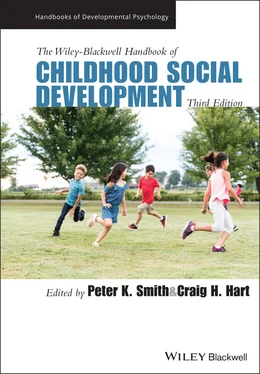Many sociocultural issues and crises arose during this era that shaped research on children’s social development. Beyond the issues detailed herein, the following were among the most influential: (a) racial, ethnic, and sexual diversity (e.g., minority/non‐minority status, prejudice and discrimination, ethnic and bicultural identity; Douglas & Umaňa‐Taylor, 2015; Fuligni & Tisak, 2014; Rivas‐Drake et al., 2014), (b) assimilation and acculturation of immigrant, migrant, and refugee children (e.g., risks, acculturative stress, resilience; Böhlmark, 2018; Ismail, 2019; Rogers‐Sirin et al., 2014), (c) gender development and transitions (e.g., transgender children, gender dysphoria, gender reassignment; Di Cegli, 2014; Ristori & Steensma, 2016; Steensma & Cohen‐Kettenis, 2015), (d) drug abuse (e.g., exposure in‐utero, Bandstra et al., 2010; Behnke et al., 2013; child and adolescent drug use, Patrick & Schulenberg, 2014; Susman et al., 2008), (d) reproductive trends and sexual development (e.g., delayed childbearing; adolescent pregnancy, Balasch & Gratacos, 2012; Geronimus, 2003; LGBTQ youth and LGBTQ parents, Farr et al., 2010; Rosario & Schrimshaw, 2013), (f) rearing alternatives and disparities (e.g., adoption, foster care; poverty, SES differences; Grotevant & McDermott, 2014; Lawrence et al., 2006; Aber et al., 2007; Letourneau et al., 2013), (g) pathways to deviance and criminality (e.g., gangs, delinquency, peer deviancy training; Allen et al., 2019; Allen et al., 2002; Bradshaw et al., 2013; Ryan et al., 2010), and (h) religious and spiritual development (e.g., religiosity; religious socialization, Bartkowski et al., 2008; Carothers et al., 2005; Hardy & Carlo, 2005).
In conclusion, readers are encouraged to contemplate a disclaimer and a recommendation. The scientific study of children’s social development has had a long history and only a portion of its recent innovations and achievements were profiled in this chapter. Given this discipline’s breadth, complexity, and longevity, it was necessary to adopt a macro perspective; consideration of specific conceptual advances within the many subdomains of social development exceeded the scope of this chapter. For this reason, readers are encouraged to consult other sources that provide a more in‐depth, detailed overview and analysis of the social development discipline and its history (e.g., chapters in this volume; Clarke‐Stuart & Parke, 2014).
1 Aber, J. L., Jones, S. M., & Raver, C. C. (2007). Poverty and child development: New perspectives on a defining issue. In J. L. Aber, S. J. Bishop‐Josef, S. M. Jones, K. T. McLearn, & D. A. Phillips (Eds.), Child development and social policy: Knowledge for action (pp. 149–166). American Psychological Association.
2 Adrian, M., Zeman, J., & Veits, G. (2011). Methodological implications of the affect revolution: A 35‐year review of emotion regulation assessment in children. Journal of Experimental Child Psychology, 110, 171–197.
3 Akingbuwa, W. A., Hammerschlag, A. R., Jami, E. S., Allegrini, A. G., Karhnen, V., Salis, H., Ask, H., Askeland, R. B., Baselmans, B., Diemer, E., Hagenbeek, F. A., Havdahl, A., Hottenga, J. J., Mbarek, H., Rivadeneira, F., Tesli, M., Beijsterveldt, T., Breen, G., Lewis, C., … Middeldorp, C. M. (2020). Genetic associations between childhood psychopathology and adult depression and associated traits in 42998 individuals: A meta‐analysis. Journal of American Medical Association, Psychiatry, 77(7), 715–728.
4 Allen, J. P., Marsh, P., McFarland, C., McElhaney, K. B., Land, D. J., Jodl, K. M., & Peck, S. (2002). Attachment and autonomy as predictors of the development of social skills and delinquency during mid‐adolescence. Journal of Consulting and Clinical Psychology, 70(1), 56–66.
5 Allen, J. P., Narr, R. K., Loeb, E. L., & Davis, A. A. (2019). Beyond deviancy‐training: Deviant adolescent friendships and long‐term social development. Development and Psychopathology, 31(5), 1609–1618.
6 Balasch, J., & Gratacos, E. (2012). Delayed childbearing: Effects on fertility and the outcome of pregnancy. Current Opinion in Obstetrics & Gynecology, 24, 187–193.
7 Ball, H. A., Arseneault, L., Taylor, A., Maughan, B., Caspi, A., & Moffitt, T. E. (2008). Genetic and environmental influences on victims, bullies, and bully‐victims in childhood. Journal of Child Psychology and Psychiatry, 49, 104–112.
8 Baltes, P. B. (1968). Longitudinal and cross‐sequential sequences in the study of age and generation effects. Human Development, 11, 145–171.
9 Baltes, P. B. (1987). Theoretical propositions on life‐span developmental psychology: On the dynamics between growth and decline. Developmental Psychology, 23, 611–626.
10 Bandstra, E. S., Morrow, C. E., Mansooor, E., & Accornero, B. H. (2010). Prenatal drug exposure: Infant and toddler outcomes. Journal of Addictive Diseases, 29, 245–258.
11 Bartkowski, J. P., Xu, X., & Levin, M. L. (2008). Religion and child development: Evidence from the Early Childhood Longitudinal Study. Social Science Research, 37(1), 18–36.
12 Baumeister, R. F., Campbell, J. D., Krueger, J. I., & Vohs, K. D. (2003). Does high self‐esteem cause better performance, interpersonal success, happiness, or healthier lifestyles? Psychological Science in the Public Interest, 4, 1–44.
13 Baumrind, D. (1967). Child‐care practices anteceding three patterns of preschool behavior. Genetic Psychology Monographs, 75, 43–88.
14 Baumrind, D., Larzelere, E., & Owens, E. B. (2010). Effects of preschool parents’ power assertive patterns and practices on adolescent development. Parenting: Science and Practice, 10, 157–201.
15 Behnke, M., Smith, V. C., & Committee on Substance Abuse and Committee on Fetus and Newborn. (2013). Prenatal substance abuse: Short‐ and long‐term effects on the exposed fetus. Pediatrics 13, 1009–1024.
16 Beilin, H. (1994). Jean Piaget’s enduring contribution to developmental psychology. In R. D. Parke, P. A. Ornstein, J. J. Rieser, & C. Zahn‐Waxler (Eds.), A century of developmental psychology (pp. 257–290). American Psychological Association.
17 Benjamin, A. (1994). Children at war. Save the Children.
18 Bernier, A., Carlson, S. M., & Whipple, N. (2010). From external regulation to self‐regulation: Early parenting precursors of young children’s executive functioning. Child Development, 81, 326–339.
19 Berry, D., & Willoughby, M. T. (2017). On the practical interpretability of cross‐lagged panel models: Rethinking a developmental workhorse, Child Development, 88(4), 1186–1206.
20 Blakemore, S‐J. (2008). The social brain in adolescence. Nature Reviews Neuroscience, 9, 267–277.
21 Böhlmark A. (2018). Integration of childhood immigrants in the short and long run – Swedish evidence. International Migration Review. 43(2), 387–409.
22 Boivin, M., Brendgen, M., Vitaro, F., Dionne, G., Girard, A., Pérusse, D., & Tremblay, R. E. (2013). Strong genetic contribution to peer relationship difficulties at school entry: Findings from a longitudinal twin study. Child Development, 84, 1098–1114.
23 Bollen, K. A., & Curran, P. J. (2006). Latent curve models: A structural equation perspective. Wiley.
24 Bornstein, M. H. (2013). Mother‐infant attachment: A multilevel approach via body, brain, and behavior. In M. Legerstee, D. Haley, & M. H. Bornstein (Eds.), The infant mind: Origins of the social brain (pp. 266–300). Guilford Press.
25 Bradshaw, C. P., Waasdorp, T. E., Goldweber, A., & Johnson, S. L. (2013). Bullies, gangs, drugs, and school: Understanding the overlap and the role of ethnicity and urbanicity. Journal of Youth and Adolescence 42, 220–234.
26 Brendgen, M. (2014). Introduction to the special issue: The interplay between genetic factors and the peer environment in explaining children's social adjustment. Merrill‐Palmer Quarterly, 60(2), 101–109.
Читать дальше












